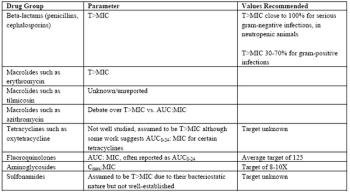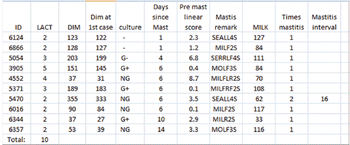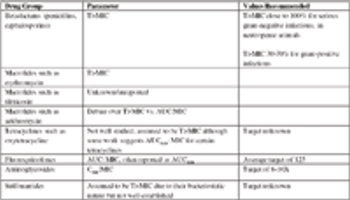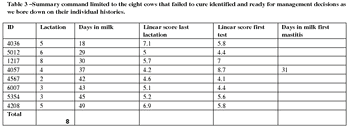
Dairy cows approaching parturition with impending colostrogenesis have a tremendous increase in demand for energy, protein, and minerals along with changes in homeostatic mechanisms.

Dairy cows approaching parturition with impending colostrogenesis have a tremendous increase in demand for energy, protein, and minerals along with changes in homeostatic mechanisms.





PDF ONLY. DO NOT LINK.



The subject of abdominal pain in camelids has been addressed a number of times over the years, with the discussion becoming progressively more detailed as we gain experience with these species. We were truly learning from scratch, as the South American approach (hands off and deal with the consequences) was generally unsuitable to North American tastes.

Traditionally, we have assumed that if a bacterial pathogen is "susceptible" to an antimicrobial, we just use the dose on the bottle or in a formulary, and the infection will be eliminated. The increasing incidence of "resistant" pathogens, i.e., pathogens requiring high concentrations of antimicrobials such that they become untreatable, has focused attention on identifying ways to reduce the selection for resistant organisms.

Drugs approved in the U.S. specifically for analgesia in cattle do not exist.

The design of antimicrobial regimens is addressed in the next section in these proceedings ("Antimicrobial Therapy: Regimen Design"), but the concepts within regimen design related to determining the concentration of drug required to inhibit growth of bacterial pathogens deserve a more thorough discussion. Antimicrobial susceptibility testing must not be viewed as a black box into which a veterinarian places a clinical sample of an infected site and receives a "yes" or "no" from the diagnostic laboratory.

Bovine respiratory disease complex includes bacterial components, which cause the classic clinical signs of lethargy, depression, and fever, with variable nasal discharge, cough, or other signs. This bacterial component of BRD (most commonly Mannheimia haemolytica, Pasteurella multocida, Histophilus somni, and Mycoplasma bovis) may be treated with antimicrobial drugs designed to kill or inhibit the growth of the pathogenic bacteria.

Opponents of food animal use rhetoric and disturbing images to incriminate lack of welfare, criticize drug usage, and incriminate modern care practices if they weren't the same method of care as in the past. They have an audience of consumers that have little or no knowledge of food animal care.

The design of antimicrobial regimens is addressed in the next section in these proceedings, but the concepts within regimen design related to determining the concentration of drug required to inhibit growth of bacterial pathogens deserve a more thorough discussion.

In this session we will take an evidence-based medicine approach to ancillary therapy of bovine respiratory disease. The literature reviewed here is not presented as being all-inclusive, but rather as a summary of many commonly cited articles on these subjects. The citations are primarily peer reviewed, but some are from freedom of information (FOI) summaries and a few are proceedings papers or abstracts.

Recently, the use of antimicrobials in food animals has been scrutinized by the general public, by federal legislators, and by public health organizations. Some of these concerns relate to the use of antimicrobials as growth promotants, while some relate to the use of antimicrobials in food animals in general.

Anyone can and everyone does deliver key performance indicators (KPI's) to the dairy who is a stakeholder of the dairy either as an employee of the farm or as a business that is supplying materials or working for the dairy.

Drugs approved in the U.S. specifically for analgesia in cattle do not exist. There are guidance documents from the FDA Center for Veterinary Medicine for companies that would like to have an NSAID approved for pain relief

Stats, floor plan, and photos of this 2010 Hospital Design People's Choice Award contestant.

Large veterinary hospital floor plan of this 2010 Hospital Design People's Choice Award contestant.

Stats, floor plan, and photos of this 2010 Hospital Design People's Choice Award contestant.

Stats, floor plan, and photos of this 2010 Hospital Design People's Choice Award contestant.

Large veterinary hospital floor plan of this 2010 Hospital Design People's Choice Award contestant.

Stats, floor plan, and photos of this 2010 Hospital Design People's Choice Award contestant.